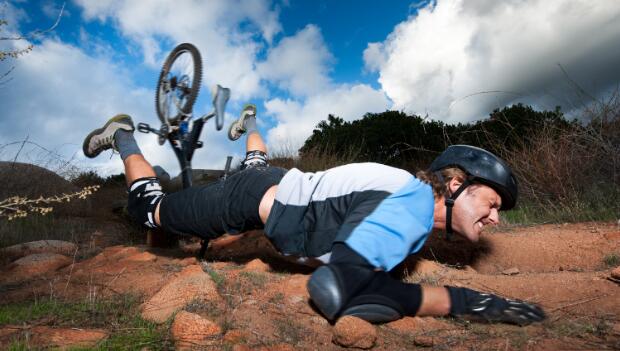
If you are a cyclist, one day your flesh will meet the earth--and not in a nice way. Call it a scrape, a strawberry, minor abrasion or road rash; but they are all basically the same injury. Sometimes this fall can include hitting your head as well.
After damage assessment, the question becomes how to heal as quickly as possible, while minimizing time off the bike. Past healing recommendations included keeping the wound covered with bandages and plenty of antibiotic ointment. The treatment cycle included hot bath soaking and scrubbing. The soak was to soften and scrub off any scabs that had formed under the bandage to minimize the scarring.
Last season, I became intimately interested in fast wound healing when I fell in love with mountain biking and fell going around a loose gravel corner. Like most endurance athletes, I have no time for injuries and I needed to heal fast. Lucky for me, only days after my crash, I traveled as coach support to a World Cup triathlon race--on the same trip was athletic trainer Diana Palmer. She introduced me to moist wound care.
Wound care is one of Diana's specialties in her job as the head athletic trainer and Sports Medicine Program Director for Westmont College in Santa Barbara. She has extensive experience patching up cyclists and various other outdoor athletes. Her suggestions and strategies helped me quickly heal from the mountain bike crash.
I had a chance to retest the protocol this season when I went down on my road bike for the first time in 20 years of training and racing. Her protocol healed a good case of road rash in four to seven days. (The deeper wounds took a few days longer than the surface wounds.)
The wound care process includes a product called Tegaderm, manufactured by 3M Corporation. It is a thin, clear dressing with adhesive on one side. It keeps water, dirt and germs away from the wound, yet it lets skin breathe. This property keeps the wound healthy and does not allow deep, scaring scabs to form. Because it is clear, you can constantly monitor the wound healing process, which is a real advantage. It is available over-the-counter at some drug stores and pharmacies.
For serious wounds, you need to be checked out by a medical professional. If your wounds are the self-care type, perhaps the tips below can help you heal quickly:
- If the injury included hitting your head, you may want to take a trip to the emergency room. Even if the hospital does a head scan that comes up negative, know that internal bleeds (i.e. Saul Raisin) can develop 24-hours to 7-days post-trauma. Know that concussions can't show up on scans or MRIs. If you've had a head injury, avoid holding your breath when lifting anything. Steer clear of pushing down hard and holding your breath, like when using the toilet. Avoid sharp changes in pulse rate or blood pressure, such as suddenly standing on the pedals of your bike to climb hard. Give your head a rest for a few days.
- Clean the wound with clean water (not stagnant stream water), a soft child's toothbrush (or a sponge) and soap. Sterile saline wound wash can be used in place of water and often used in athletic trainer kits because it puts out a stream that helps flush wounds. Baby shampoo works well for the soap because it is mild. The biggest issue in this part of the process is cleaning the wound thoroughly. Most people won't clean their own wounds well enough because it is really painful. If you or someone you know cannot do a good job of really cleansing the wound, go to an urgent care office to get cleaned up. The last thing you want to deal with is a nasty infection.
- If the wound is an abrasion and not free-bleeding, use hydrogen peroxide for the first day only.
- Get a Tetnus shot if you have not had one within the last 10 years.
-
Put an antibiotic on the wound (examples include Bacitracin, Polysporn, Neosporne) and cover it with Tegaderm. Know that antibiotic ointments can be overused and can cause skin reactions, allergic responses, as well as set up a resistance-bacterial growth cycle. If you do prefer the use of an ointment on your minor wounds, follow these suggestions:
- Apply any antibacterial ointment to a well-cleansed wound to avoid "sealing in" bacteria.
- Apply a very thin layer of ointment. This will coat and protect the wound.
- Use a clean swab or sterile gauze to apply the ointment. Do not apply ointments directly from the tube, to avoid contaminating the tube and any future wounds.
- You can apply ointments up to two times daily; however, always clean the wound before each new application of ointment.
- Remove the Tegaderm by peeling it from the top to the bottom.
- Unless there are signs of infection, you can stop using antibacterial ointments after 24 to 48 hours; but continue to cover the wound with Tegaderm.
- Watch the wound daily. Change the Tegaderm as needed, particularly if excessive exudite (wound pus) develops. Some fluid build up under the Tegaderm is normal. Watch for dark yellow, green or brown exudite, excessive redness, increasing pain, fever or red streaks moving up the extremity. Change the dressing as necessary and see your medical professional if any worrisome conditions develop.
- Keep the wound covered with Tegaderm until the redness, the wound or both are gone.
- Protect the newly healed wound from the sun by using sunscreen with a sun protection factor of 30+. New skin is very sun sensitive.
If it is your turn to take a tumble, perhaps this process can help you heal as fast as possible.
Many thanks to Diana Palmer for her contributions to this column and my personal wound care.


